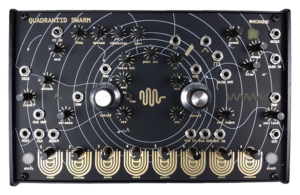Back in begin of November, Eowave launched their Kickstarter campaign for their experimental Quandrantid Swarm Synthesizer. Already at Superbooth this year, the company showed a first prototype of this very interesting digital/analog instrument. Several months have passed and Eowave has brought the second prototype to the Toyko Festival of Modular.
The second prototype has been improved with several new features like the 8 different play modes like a polyphonic mode. If you are more a experimental musician than check out this amazing Synthesizer that allows to create soundscapes and wired sounds.
The Quadrantid Swarm
The Quadrantid Swarm is a desktop touch synthesizer aimed at sound designers and musicians who are looking for an expressive tool to explore rich and unusual soundscapes with a direct intuitive approach.
Past research and development at eowave has contributed to a range of successful products aimed at musicians and performers – including sensor interfaces, MIDI devices, modular Synthesizers and more. This has been honed and distilled in the Quadrantid Swarm. It is an instrument that has been designed openly – to be used with MIDI, alongside your modular Synthesizer/CV sequencer or to be explored as a standalone drone/sequencer/generative Synthesizer.
Features:
Oscillator: The oscillator section is a digital wave generator. In sequencer mode (activated when you push start) the spread control multiplies the waveform up to 8 waveforms. In live mode (sequencer not active) the spread control will not affect the oscillator because the 8 waveforms are spread across the touch keyboard to be used as a simple polyphonic synthesizer. Character controls a different effect or folder depending on the mode. The character effects/folders will help you design timbres that will range from clean and glassy to dense and distorted.
Percussion: Tied to the fundamental frequency of the main oscillator is a percussive element. The type of synthesis implemented is different for each mode.
Mixer: A simpler mixer section, feeding into the two filters directly below, comprises of three inputs. One for the oscillator voice, one for the perc voice, and one spare. The spare input can be used to patch in an external signal, utilising the filters. With nothing patched in, the third input is pre-patched as a feedback for the spring reverb (which will overdrive/distort with high gain levels to great effect).
Filter: Two 12db filters, based on our ‘fluctuations magnétiques’ module. Filter 1 can be switched between high or low pass. Filter 2 is low pass. Using the two filter poles together you can create a bandpass and other interesting filter shapes. This allows for rich, throaty and deep sound sculpting.
Modulation: Two modulation sources unlock the expressivity of the synth. The first is an envelope, pre-patched to the cutoff on filter 1, and also patched to the VCA. The LFO section is pre-patched to the cutoff of filter 2 and features seven selectable waveforms via the shape function, and an 8th mode which is the sequencer CV out (allowing the sequencer to be patched to other devices). Speed is set using the speed knob. A square output has been included which can be useful for triggering clock resets and other timing functions. A slew in, out and attenuator has also been implemented to further your modulation experiments.

Reverb: An analog spring reverb adds bundles of character to the QS, and can be mixed and used to feedback into itself for chaotic overdrives. The reverb section can be used independently of the synth with your other devices, by patching a cable to REV IN, and using the main output.
VCA: A simple VCA can be patched to the envelope, LFO or external source to amplify the QS.
Interfacing (MIDI, CV and audio inputs): We will be including a standard MIDI to 3.5mm adaptor to use in your live or home setup. CV, trigger, clock and reset inputs are also featured to use with eurorack standard devices.
Pre-patching: We designed the QS for immediate use without having to worry about complex patching, so pre-patching is used to make connections in logical places. Some of these are highlighted using arrows, particularly the modulation sources and connections, the audio routing hasn’t been highlighted to keep the design clean, but is explained above.
Capacitive touch keyboard To select a mode, hold shift and press the desired key. In live mode (sequencer inactive) you can play the keys as a traditional keyboard. Pots 1-8 are to tune each step. Press start to begin sequencer mode. Now each key acts as a gate on/off. Active gates are represented with a red LED. Press start again to stop the sequence and return to live mode.
The Quadrantid Swarm Synthesizer is now available for pre-order on Kickstarter for an early bird start price of 425€. (RRP 499€) ($599 USD) Shipping starts in April 2018.
More information here: Quandrantid Swarm Synthesizer

Be the first to comment